Blue Farm is the name given to cEDH’s most popular deck, which plays Tymna the Weaver and Kraum, Ludevic’s Opus as its commanders. I’ve been playing a lot of cEDH, but have barely played most of the popular decks, since I have more fun building my own. My ultimate goal is to build something better than the existing decks. I finally feel like I’ve come far enough to recognize my playstyle in cEDH and understand how it differs from other people, and also understand the strengths of Blue Farm that I’d like to have access to, so I’ve decided to build my own take on the deck.
What I appreciate about the deck is maximizing access to the best card draw engines, an efficient combo which wins the game, and access to white cards that prevent interaction when going for the combo finish. What I don’t like is the deck’s attempts to play as a turbo combo deck, including Ad Nauseum and the supporting rituals.
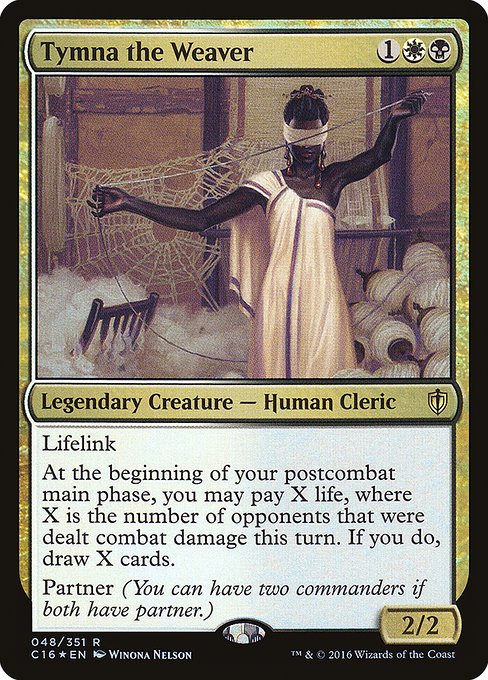
It might be a result of the pods I’ve played in, or it might be mistakes me opponents make, but I believe less than half the Ad Nauseums that have resolved against me have resulted in the player who cast them winning the game, and a lot of the time, it doesn’t resolve at all. I think the deck building costs to supporting Ad Nauseum are high, just in terms of the cards you can’t play because of their casting cost, and the payoff isn’t all that good. I also hate drawing cards which I have to hold in my hand for a long time that can’t interact with my opponents. I want to either be able to play my card right away to start getting value from it or I want it to be able to interact–I don’t want to have a hand full of cards just waiting for later that can’t protect me. Expensive cards like Ad Nauseum result in hands that don’t do anything, and rituals either play the same way, or I have to use them to get out ahead early. I usually think spending cards for a more threatening board presence it a way to trade resources with the table at a disadvantage and ultimately lose.
I’m looking for slow and steady–I want my deck to be very good at not losing, good at playing a fair game, and good at sculpting a hand to capitalize on a win at the right moment. I don’t care very much about my ability to race in an all turbo pod.
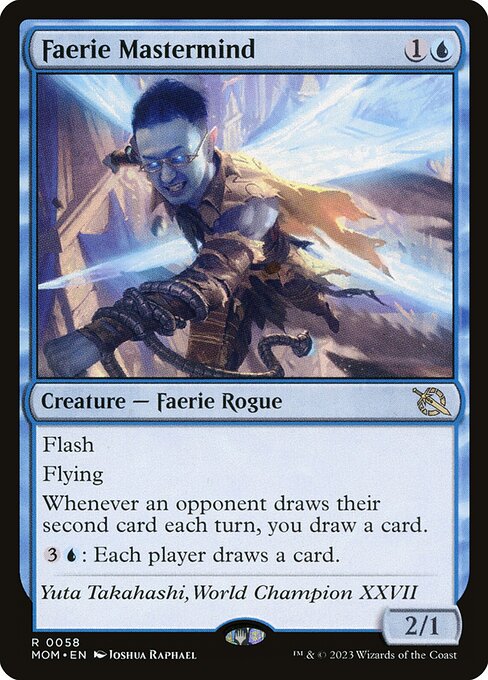
What I Added
There are a lot of different ways that people build Blue Farm, and I’m not sure what the best aggregate deck is, so I’ll compare mine to Brian Coval’s deck from Punt City 2. I expect it’s a little outdated, but aside from not including new cards, I’m guessing it’s pretty standard.
I like the decks passive card advantage engines, so I’ve added to what Brian played–I have Faerie Mastermind, Archivist of Oghma, Deep Gnome Terramancer, Lotho, Corrupt Shirriff, Talion, the Kindly Lord, and The One Ring. The most similar cards I don’t have are Loyal Apprentice and Ragavan, Nimble Pilferer. So I have a lot more passive card/mana advantage. To me, this makes up for not having Ad Nauseum–I won’t get a big burst of cards from that, but I’m more likely to have more cards otherwise.
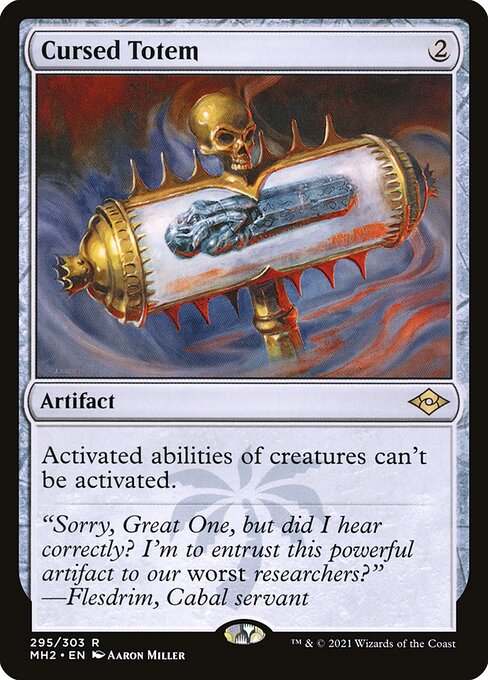
I want more interaction so that it’s harder for me to lose and I’m better at playing a long game. Where I can get more value from the cards listed above, to support that I have additional interaction and stax pieces in the form of Pyroblast, An Offer You Can’t Refuse, Resculpt, Cursed Totem, Reprieve, Subtlety, Gilded Drake, Orcish Bowmasters, Muddle the Mixture, and Deadly Rollick. The interaction I don’t have is Snap and Damn. I don’t have Damn because I have more creatures of my own, so I’m less likely to want to clear the board. I have mostly spot removal.
So, those are the things I wanted to be good at, and I have a lot more cards that do both of those things, so lets look at what I’m giving up.

What I Cut
I have fewer tutors. Brian has Diabolic Intent, Mystical Tutor, and Wishclaw Talisman, and the only tutor I have that he doesn’t is Muddle the Mixture. I play Enlightened Tutor because it can efficiently find Mystic Remora or Rhystic Study to give me a card advantage engine. Mystical Tutor doesn’t do that–it doesn’t have a default card it wants to find early, instead, it’s to be used strategically later or to find a combo. The result is it’s a card that can rot in your hand, and the payoff isn’t good enough for me to accept that. Wishclaw Talisman I think is too much mana, and bad against Collector Ouphe type effects. I just don’t like the card much. Diabolic Intent is a card I’m open to, but my deck doesn’t have many creatures I want to sacrifice, and I think the cost of investing a creature in addition to mana into something is just too great. Just another spot where I think the cost is too high to be worth it.
I don’t have Final Fortune. I know some players swear by this effect. I think it’s pretty important with Ad Nauseum because it lets you win with a lot less mana post Ad Nauseum, but otherwise, I don’t think it’s great, and it’s a card that’s guaranteed to eat space in my hand for the entire game after I’ve drawn it.
I have much less fast mana–I don’t have Dark Ritual, Mox Opal, Culling the Weak, Simian Spirit Guide, Cabal Ritual, Rite of Flame, Talisman of Creativity, Talisman of Dominance, or Grim Monolith–so this is where I got all the space.
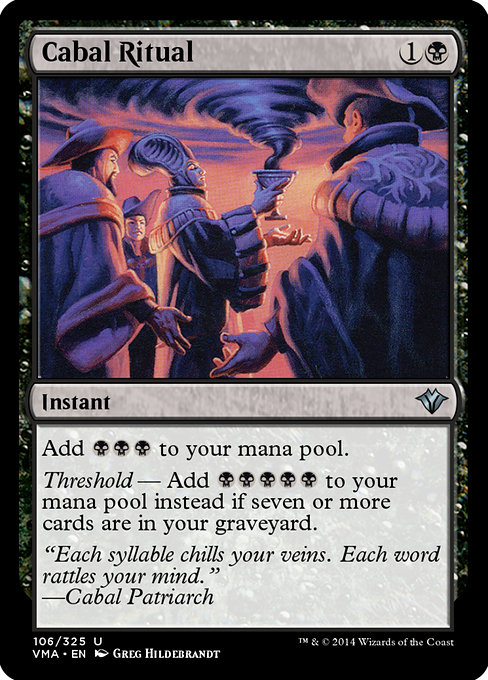
So do I just have less mana? Not exactly–we have the same number of lands, but I also have Lórien Revealed and Troll of Khazad-dûm, plus Lotho and Deep Gnome Terramancer, as mentioned above, so I don’t exactly have less mana. If you count the land cyclers as equivalent to the Talismans as permanent mana sources, I’d argue Lotho and Deep Gnome are more reliable mana than any of the other cards. I have fewer mana burst effects, but more stable mana altogether. Also, Mox Opal is a little ambitious so I only kind of count it as a mana source. While I think my deck is less explosive, I don’t think it’s worse at being able to cast spells, which is important to me.
I don’t have Wheel of Fortune. Wheel can be important to rebuild after using rituals, and generally plays well with more mana rocks and rituals to give you some really explosive openings. Given that my deck is designed to sculpt its hand over time and to be less explosive, it’s a very bad fit in my deck and would usually play as the exact kind of card I like to avoid–a sorcery that clogs my hand.
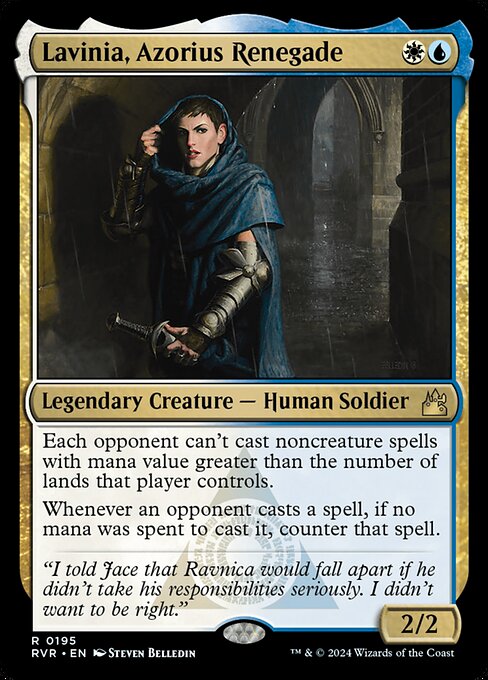
I don’t have Lavinia, Azorius Renegade. This I might add to my deck at some point. It can be really good, but it can also backfire a little when you need someone else to be able to stop another player from winning by using a free counter. For that reason I kind of prefer Boromir, Warden of the Tower, but three mana creatures play much worse with Tymna. It didn’t make it because I prefer the other creatures. It’s also a better fit if you’re trying to play shorter, more proactive games, as the ability to prevent expensive spells matters more in short games and preventing zeroes helps you more when you’re more likely to be going for a win.
I don’t have Loyal Apprentice or Ragavan, Nimble Pilferer because neither has really impressed me. Ragavan can be pretty great early, but tends to be very bad after the first turn or two. While I was optimistic about Loyal Apprentice and even tried playing it, I didn’t love it the few times I drew it due to lack of immediate payoff when played on curve. I felt like I was good enough at using Tymna due to my higher creature count.
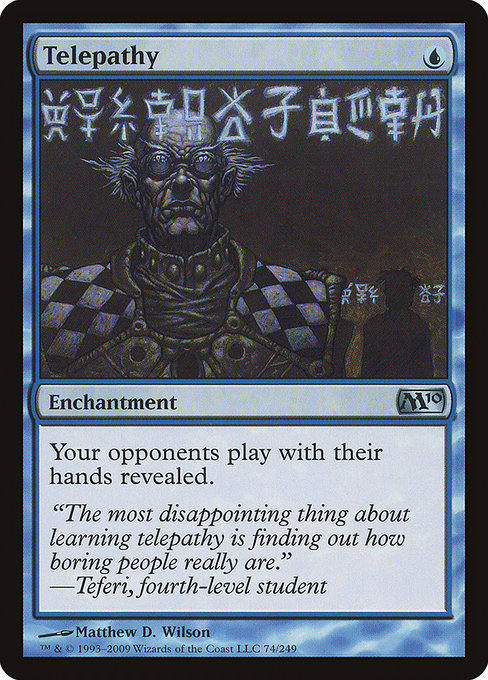
The one other card I’m playing is Telepathy. This isn’t really comparable to other cards because it doesn’t exactly have any intrinsic impact on the game. It’s a weird card because so much of its purpose is political, and it’ll play differently for different players in different groups. I’ve had a theory for a long time that it’s very strong in cEDH, but I kept not putting it in decks because no one else plays it.
Telepathy has two important effects. First, it shows you everyone’s hand, which means you always know whether the table can stop anything you’re trying to do. Because it doesn’t reveal your hand, no one else gets this perfect information.
Second, it shows the other players everyone else’s hand. This means if anyone has something threatening in their hand, everyone will know to treat them as a threat, but more importantly, it means everyone knows who has answers. Players are less likely to attempt a win into counterspells they can see, and when someone does try to win into a known counterspell, you don’t have to act, because you know someone else can stop it. This means the game generally slows down a little, as people take fewer risks (unless it reveals that no one has anything). Assuming it slows the game down, that’s very good for my deck that’s built to grind over a long game.
I’ve heard a lot of theories about how Telepathy backfires in practice. I’ve only recently started playing it, but that hasn’t been my experience, and I also don’t think it’s realistically very likely that it will. Currently, I’m very happy with what it offers for one mana, but it’s definitely a card I need to see in play a little more.
It’s kind of weird to start playing the deck to beat and immediately change it by over 20 cards, since it means I’m not really getting the benefit of getting reps in with a deck I expect to play against a lot. But, I strongly believe in building decks in commander to be played the way you’re going to play them, and given that I know I’m very risk averse, the advantage of being able to take more explosive lines isn’t very useful for me. I’m pretty sure I’ll do better with my version of the deck than I would with Brian’s. That’s not to say I think my deck is better. I suspect Brian would do worse if he picked up my deck, since he’d be used to playing his–he’d probably be frustrated by not being able to take lines he usually takes, but for me, this list is a way to play my kind of game while getting access to the core strengths of the deck that I want to take advantage of.
Sam Black (any) is a former professional Magic player, longtime Magic writer, host of the Drafting Archetypes podcast, and Twitch streamer. Sam is also a Commander Cube enthusiast, and you can find Sam’s cube list here. For anything else, find Sam on Twitter: @SamuelHBlack.

